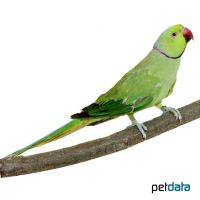Rose-ringed Parakeet Green (Psittacula krameri)
| Rose-ringed Parakeet Green Psittacula krameri | |
|---|---|
| Name | Rose-ringed Parakeet Green |
| Name Lat. | Psittacula krameri |
| Family | Elegant Parrots |
| Family lat. | Psittaculidae |
| Order | Parrots |
| Order lat. | Psittaciformes |
| Origin | Africa, Asia |
| Climate | Subtropical - tropical |
| Diet | Large Parakeet seed, greens, fruits |
| Keeping | Pair, group |
| Care Level | Easy |
| Reproduction | Cavity nest |
| Life Span | 20 years |
| Protection | No |
| Metric Units | |
| Size | 40 cm |
| Temperature | 20-26 °C |
| Housing | 200 x 100 x 100 cm |
| US Units | |
| Size | 16" |
| Temperature | 68-79 °F |
| Housing | 80" x 40" x 40" |
Distribution and habitat
Collared parakeets are widespread from central Africa to the front and back of India, where they live in forests and cultivated land up to 1,600 meters above sea level. They are bred in different color varieties.
Cage size
The minimum cage size is 200 x 100 x 100 cm (L x W x H) for a pair. The cage size must not be undercut even in case of justified single keeping. For an additional 2 birds, assuming species compatibility, the floor space must be increased by 50%. The cage must be placed at a height of at least 80 cm (except aviaries) in a bright, draught-free and quiet place and should have cross-wiring or netting. Keeping in an aviary with a floor area of at least 3 m² is preferable to keeping in a cage.
Maintenance
The floor must be covered with sand, shavings of untreated wood or similar material and cleaned once a week if possible. At least 2 perches made of wood or branches of different thickness and height are to be installed in such a way that the longest possible flight path is created. They need a bathing opportunity and should also be sprayed with water occasionally (e.g. sprinkler system). Rings, ropes, and natural branches that are not harmful to health should be offered for occupation. They should be kept at room temperature.
Diet
The species-specific feed offer consists of mixed seeds, available in specialized trade as "large parakeet feed" in premium quality, supplemented with cob millet, green feed (dandelion, chickweed, green panicle millet), half-ripe corn cobs, vegetables (peppers, carrots, etc.).), fruits (e.g. apples, figs, grapes), fresh twigs, buds, occasionally mealybug larvae, and especially for raising young, germinated seeds (oats, wheat), mealybug larvae, and egg feed. If there are several animals, set up several feeding stations. They need grit, cuttlefish and vitamin lime as digestive aids. Drinking water must always be available in birdbaths or in stable, open containers and, like food, must be offered fresh daily in clean containers.
A varied diet promotes health and prevents deficiency symptoms.
Reproduction and breeding
The male has a black throat and a pink neck band.
They breed in nest cavities or in hollowed tree trunks. Sawdust from coniferous wood and mulch are particularly suitable as bedding. The clutch consists of 3-5 eggs and the incubation period is about 23 days. The incubation period is, biologically speaking, from March to August when the birds are kept in open-air aviaries. Young birds must be raised to be species-appropriate. The average life expectancy can be 20 years.
Important
Collared parakeets should be provided with a leg ring.
They may only be kept in pairs or in a group and not chained or on a hanger. The collared parakeet has the most extensive natural range of any parrot. They are considered partially domesticated and have been intentionally or unintentionally released into the wild in many parts of the world. There are also free-living populations in Germany
When kept in outdoor aviaries, they also need a heated shelter of at least 1 m², which can be visited by the birds at any time. The temperature in the shelter must not fall below 5 °C and the furnishings must correspond to those of cage husbandry
Sufficient daylight or flicker-free artificial light (stroboscopic effect) corresponding to daylight must be provided in rooms, including the shelters. The lighting duration shall be 8-12 hours per day and the natural day-night rhythm shall be observed. Adequate indoor climate should be provided. If caged, they should be allowed free flight. The health condition of the birds should be checked daily
Further literature can be found in your pet store.
References
Text: petdata; Image: petdata
Source: BMELV (1995): Tierschutzgutachten - Mindestanforderungen an die Haltung von Papageien; ARNDT (1997): Lexikon der Papageien, Arndt Verlag; GRUMMT & STREHLOW (2009): Zootierhaltung - Tiere in menschlicher Obhut: Vögel, Verlag Harri Deutsch
- Gemäß § 21 Abs. 5 Tierschutzgesetz idgF
